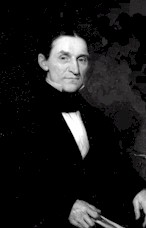Cyrus Peirce facts for kids
Quick facts for kids
Cyrus Peirce
|
|
|---|---|

Cyrus Peirce 1790-1860
|
|
| Born | August 15, 1790 |
| Died | April 5, 1860 |
| Resting place | Nantucket, Massachusetts (Prospect Hill Cemetery) |
| Education | Harvard University |
| Occupation | Educator and Unitarian minister |
| Known for | Founding president of first state normal school, now Framingham State College |
| Spouse(s) | Harriet Coffin |
Cyrus Peirce (born 1790, died 1860) was an important American teacher and minister. He is famous for starting the very first public school in America that trained teachers. This school later became Framingham State University.
Contents
About Cyrus Peirce
His Early Life
Cyrus Peirce was born on August 15, 1790, in Waltham, Massachusetts. He was the youngest of twelve children. He went to Framingham Academy, which was a school, before attending Harvard. While he was still a student at Harvard, he started teaching in West Newton in 1807.
After finishing his degree at Harvard in 1810, Peirce moved to Nantucket Island. There, he became the head of a private school. After two years, he went back to Harvard to study divinity, which is the study of religion. He finished these studies in 1815. Then, he returned to Nantucket and continued his teaching career.
On April 1, 1816, Cyrus Peirce married Harriet Coffin in Nantucket. They did not have any children.
His Career as an Educator
In 1818, Peirce left Nantucket to become a preacher. He became a Unitarian minister in North Reading in 1819. He worked there until 1827, when he decided to lead a school in North Andover. He stayed there until 1831.
In 1831, Peirce went back to Nantucket and opened a "School for Young Ladies." In 1832, a fourteen-year-old girl named Maria Mitchell became one of his students. Maria later became a very famous astronomer. She even became Peirce's assistant for a while before starting her own school.
In 1838, Peirce became the first principal of Nantucket High School. However, he left in 1839 because Horace Mann, a well-known education reformer, asked him to. Mann wanted Peirce to lead the first public normal school in the country, which was in Lexington.
A normal school was a new kind of school that trained people to become teachers. Peirce was the first head of this important new school.
In 1841, Peirce wrote about his teaching methods at the Lexington Normal School:
You ask for a full account of my manner of instruction in the art of Teaching. This, it is not easy to give. From what I say, you may get some idea of what I attempt; and of the manner of it. Two things I have aimed at, especially in this school. 1. To teach thoroughly the principles of the several branches studied, so that the pupils may have a clear and full understanding of them. 2nd, to teach the pupils by my own example, as well as by precepts, the best way of teaching the same things effectually to others. I have four different methods of recitation. 1st, by question and answer; 2nd, by conversation; 3rd, by calling on one, two, three, more or less, to give an analysis of the whole subject contained in the lesson, and 4th, by requiring written analyses in which the ideas of the author are stated in the language of the pupil. I do not mean that these are all practised at the same exercise. The students understand that, at all the recitations, they are at perfect liberty to suggest queries, doubts, opinions.
The normal school in Lexington started small with only three students. But by July 1842, it had grown to 42 students! However, Peirce had to leave his job because he became ill. He returned to Nantucket.
By 1844, the school had moved to West Newton. Peirce was convinced to return and lead the school again in July 1844. He worked there until May 1849, when he had to resign again due to poor health. While at the school, he ended each class by telling his students to "Live to the Truth." These words are now the motto of Framingham State University, which recognizes him as its first president.
After leaving the normal school, Peirce traveled to Europe in 1849. He was a delegate at the third International Peace Congress. He toured Europe and England before returning to West Newton.
Later Life
After returning from Europe in 1850, Peirce worked with Nathaniel Topliff Allen at Allen's Academy in West Newton. This academy took over the buildings where the normal school used to be. Peirce's health issues continued, but he remained connected with the academy until he passed away.
Cyrus Peirce died on April 5, 1860, in West Newton. He is buried in Prospect Hill Cemetery in Nantucket. The students of the normal school put up a monument for him. It is a Celtic cross with his famous motto, "Live to the Truth," carved into it. His wife, Harriet Peirce, died in 1884 and is buried next to him.
His Legacy
Several places and schools are named after Cyrus Peirce to honor his contributions to education:
- Cyrus Peirce Middle School in Nantucket
- Peirce School in West Newton
- Peirce Hall at Framingham State University
- The First Unitarian Society in Newton has a stained glass window dedicated to education. It shows Horace Mann and Cyrus Peirce.
Images for kids


